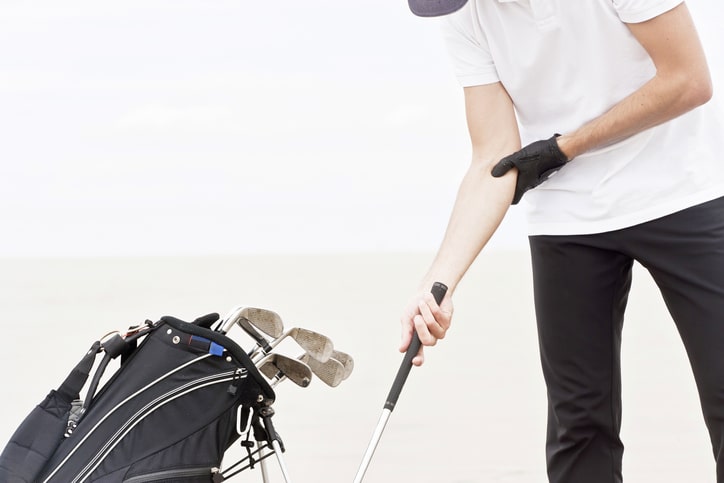
Golfer’s elbow is a painful condition that can often be mistaken for tennis elbow. While it is common among golfers, you don’t have to be a weekend duffer to develop it. You can treat golfer’s elbow with noninvasive measures, though you may need to see a doctor if the condition doesn’t improve.
What Causes Golfer’s Elbow?
Golfer’s elbow impacts the forearm, where your tendons attach to the inside of the elbow. Sometimes severe pain can radiate into your wrist. Like tennis elbow, golfer’s elbow is an overuse injury that stems from making the same movement over and over. The most common symptoms are stiffness and pain in the elbow and forearm.
Your doctor will diagnose you through a physical exam and by looking over your medical history. They may send you for an X-ray to ensure you don’t have a fracture. MRI can also be used for diagnosis.
How Do You Get Golfer’s Elbow?
Forceful motions using the fingers and wrist can lead to golfer’s elbow. Sufferers often repeat movements such as hitting or throwing without warming up properly. Some common causes of golfer’s elbow, in addition to playing golf, include the following:
- Playing racket sports such as tennis may lead to injury. Applying a lot of topspin to the ball or using a racket that’s too small for you can increase your pain.
- Playing throwing sports such as baseball or softball can also hurt your arm.
- Lifting weights without proper technique, such as curling your wrists when you work on your biceps, can cause golfer’s elbow.
- Working in professions such as carpentry, plumbing and construction can also hurt your arm.
You may be at greater risk of developing golfer’s elbow if you smoke, are over 40 years old or spend more than two hours a day performing a repetitive activity.
How to Fix Golfer’s Elbow
The first step in treating golfer’s elbow is to stop engaging in the activity that caused the injury. You can give up a hobby relatively easily, but if you believe your profession caused your pain, see your doctor to explore your options.
You can also use at-home methods to seek relief. Try the following:
- Apply Ice: Put ice on your elbow for 15 to 20 minutes several times a day. You should put a towel around the ice pack so your skin doesn’t get damaged. Try using the ice to massage the inner elbow for a few minutes during each application.
- Stretch the arm: Ask your doctor for stretching exercises that can also strengthen your forearm. Loading the tendon can be the best way to ease the pain.
- Buy a brace: Wear a counterforce brace on the arm to decrease muscle and tendon strain.
What Can You Do to Prevent Golfer’s Elbow?
If you want to avoid getting golfer’s elbow, consider these steps to help prevent you from developing it in the first place.
Stretch
Before you work on strengthening your arms, it’s important to stretch. Stretching helps get your blood flowing and raises your muscle temperature, allowing more flexibility during your workout. Otherwise, you risk injuring yourself instead of building your strength. If you’re already injured, you can hurt yourself even further. We recommend trying basic hand and wrist stretches before moving onto strengthening exercises, such as:
- Repeatedly making a fist.
- Opening and closing your fingers, or abduction and adduction of your fingers.
- Wrist flexions and extensions, using as much range of motion as possible.
Strengthen
Strengthening the muscles in your arms, wrists and hands is the best thing you can do to prevent a case of golfer’s elbow in the future. As with any part of your body, the more you use your forearms and help them build muscle, the more you’ll be able to do on a daily basis without risk of injury. These exercises are some of the best to help you gain strength in your forearms, wrists, hands and fingers:
- Lateral wrist extensions.
- Seated dumbbell wrist curls and reverse wrist curls.
- Finger curls.
For these exercises, you’ll need a dumbbell. While the weight of the dumbbell depends on your body and strength level, it should generally be between five and 20 pounds.
Stop
Finally, if you start to experience pain while exercising, stop! Take time to let yourself rest and recover. If you must continue with your exercises, try to slow down or find an easier variation that doesn’t cause you pain.
How Long Does Golfer’s Elbow Take to Heal?
It takes about three to six months to heal golfer’s elbow through noninvasive methods. Not everyone sees results from this approach, however. If you engage in exercises and other therapy and don’t see a difference, OrthoBethesda can help. Contact us to learn more or set up an appointment.
Related Content
- What’s the Difference Between Golfers Elbow and Tennis Elbow
- 7 Tennis Elbow Exercises to Treat Your Pain at Home
- How Long It Takes for Tennis Elbow to Heal
- Top Exercises to Avoid If You Have Tennis Elbow
- Exercises You Can Do for Tennis Elbow
- Biceps Tendonitis
- Tenodesis vs. Tenotomy
- Everything to Know About Tommy John Surgery
